|
Special Features





Image Libraries


|
|
Blog
Both streetcars and buses come in many shapes and sizes, but if you need the capacity, streetcars can be much bigger. So far neither DC nor Arlington has proposed a streetcar this long, but they’re possible.
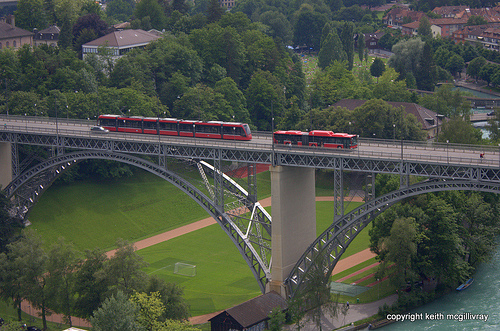
Tram and bus in Bern, Switzerland. Photo by Keith McGilivray on flickr.
Average Rating: 4.6 out of 5 based on 184 user reviews.
February 13th, 2013 | Permalink
Tags: bus, streetcar, transportation

|

Photo by sbluerock on flickr. |
When is a moratorium, for liquor or otherwise, useful? When is it not?
Theoretically, local moratoriums on certain types of development can strengthen neighborhoods by encouraging a broader mix of uses. Unfortunately, they rarely actually work that way. More often, moratoriums are misused by opponents of growth in general, to try and slow or stop change.
As DC debates the possibility of a moratorium on liquor licenses on U Street, it’s worth discussing the issue more seriously than yesterday.
The basic truth of moratoriums is that they don’t usually stop things, but rather move them somewhere else. Banning bars on U Street doesn’t eliminate demand for bars, it simply pushes any new supply to the next best location. Residential moratoriums, which are sometimes used in fast growing suburbs, are the same.
So any discussion of a local ban on any particular use needs to consider where that use is most appropriate. It’s not enough to just say “I don’t want more of X in my neighborhood.” We have to plan where we do want that use, make sure it can happen there, and then plan what we want in the banned location instead.
Malls versus neighborhoods
One of the advantages suburban malls have over urban neighborhoods is total control of the merchant mix. Mall owners know that it’s important to have a wide variety of stores, so the best malls typically lease spaces to shops that will improve their mix, rather than those that will pay the highest rent.
When you’re at a mall and Verizon has a big luxurious shop, but AT&T and T-Mobile only have little carts, it isn’t because AT&T and T-Mobile can’t afford to outbid that shoe store down the hall; it’s because the mall owner will only lease out one big space to cell phone providers.
That isn’t limiting the free market. On the contrary, it’s taking a broad long term view of the market.
Urban neighborhoods usually can’t be as selective, because every building has a unique owner. Mall owners are concerned about the overall profit of the entire mall, so they can turn down high leases on individual storefronts if they think it will pay off with a little more business everywhere else. But if you only own one individual storefront, you’re going to maximize it with the highest paying tenant you can find.
That sometimes results in neighborhoods with a bad mix of stores. We certainly see that in DC, where many of our retail strips have a glut of bank branches, cell phone stores, and pharmacies.
So if used carefully, moratoriums can help level the playing field for urban neighborhoods with a lot of small land owners. If the neighborhood is desirable enough to fill all its storefronts regardless, and if the moratorium is thought of as more of a way to promote something new rather than limit something old.
But moratoriums shouldn’t be tossed around lightly. The key is to plan for what you do want and then make it happen. Moratoriums fail when they’re used without a master plan guiding them towards a specific goal.
And sometimes, it’s worth having a high ratio of certain things. For example, as a regionally-significant nightlife district, it’s acceptable for U Street to have a lot of bars.
 Cross-posted at Greater Greater Washington. Cross-posted at Greater Greater Washington.
Average Rating: 5 out of 5 based on 182 user reviews.
February 12th, 2013 | Permalink
Tags: government

|
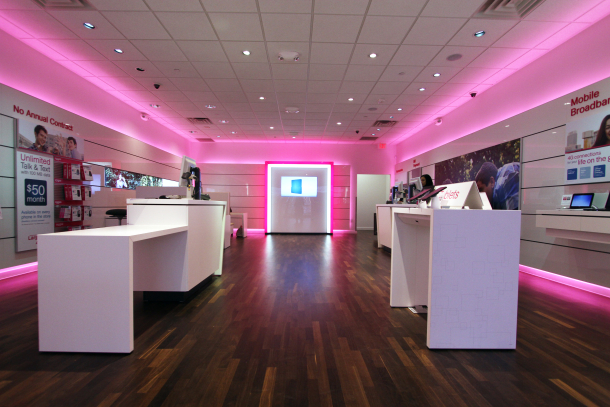
T-Mobile store. Image from T-Mobile. |
Someone has proposed a moratorium on liquor licenses in the U Street area. It seems unlikely to pass, but regardless, here’s a partial list of things I’d rather ban proliferation of in DC:
- Bank branches. In the age of ATMs, banks are offices, not retail. They have a deadening effect on sidewalk life and drive up the cost of retail space for everyone else.
- Cell phone stores. Proliferation of luxurious cell phone stores is proof that we’re all paying way too much for cell phone service.
- Pharmacies. Unlike cell phone stores, it is an important convenience for every neighborhood to have a CVS or Wallgreens. But after the 3rd one opens in your neighborhood, are you really excited about a 4th?
- Froyo stores. I like froyo, but it’s obviously a bubble that’s about to burst. No way can so many survive long term.
- Empty storefronts. Griping above notwithstanding, we shouldn’t ban anything as long as we have empty storefronts. Even that bank branch is better for sidewalk life than nothing.
Average Rating: 4.6 out of 5 based on 177 user reviews.
February 11th, 2013 | Permalink
Tags: economy, law

This was spotted on a bus in Manchester, UK, where apparently the phrase “war on cars” takes on new meaning.

Photo from reddit user Onoj.
Average Rating: 4.9 out of 5 based on 282 user reviews.
February 7th, 2013 | Permalink
Tags: bus, fun, transportation

|
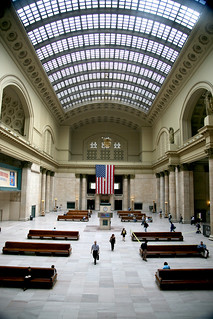
Chicago Union Station, busiest outside the Northeast. Photo by Vincent Desjardins. |
As a follow-up to Monday’s map of Amtrak stations by ridership, here are the 10 busiest, ranked in order. Although it’s not surprising that New York, Washington, and Philadelphia are the top 3, it is pretty surprising that 2 of the top 5 and 4 of the top 10 are nowhere near the Northeast.
Number 1: New York Penn Station
8, 995, 551 boardings/deboardings per year.
Number 2: Washington DC Union Station
4, 850, 685 boardings/deboardings per year.
Number 3: Philadelphia 30th Street Station
3, 872, 392 boardings/deboardings per year.
Number 4: Chicago Union Station
3, 393, 695 boardings/deboardings per year.
Number 5: Los Angeles Union Station
1, 606, 121 boardings/deboardings per year.
Number 6: Boston South Station
1, 360, 162 boardings/deboardings per year.
Number 7: Sacramento Valley Station
1, 175, 046 boardings/deboardings per year.
Number 8: Baltimore Penn Station
953, 170 boardings/deboardings per year.
Number 9: Albany-Rensselaer Station
769, 626 boardings/deboardings per year.
Number 10: San Diego Union Station
753, 739 boardings/deboardings per year.
The rest of the top 25 includes most of the secondary stations in the northeast, like Wilmington (12), BWI Airport (17), and Harrisburg (21), plus 6 more stations outside the northeast. Those are Seattle (14), Portland (15), Irvine (16), Milwaukee (19), Emeryville (20), and Bakersfield (24).
Average Rating: 5 out of 5 based on 218 user reviews.
February 6th, 2013 | Permalink
Tags: intercity, top10, transportation

|
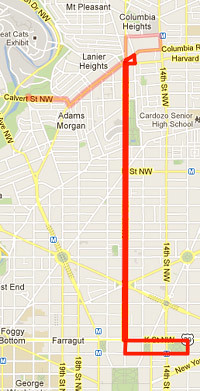
What the new S3 bus route *could* look like. Pink lines are alternate routes. |
WMATA is considering tweaking the busy 16th Street bus line with a new route that would run only between Columbia Heights and downtown. The change is proposed to relieve extreme crowding on the S-series Metrobuses.
Why it’s necessary and fair
Imagine if most rush hour Orange Line trains blew through all the Arlington stations without stopping. Would that be fair to riders in the Rosslyn-Ballston corridor?
That’s essentially what is happening today on WMATA’s 16th Street bus line. It’s so crowded during peak hours that buses often have to stop picking up passengers, forcing riders south of Columbia Heights to watch while one bus after another passes by without stopping.
WMATA added more articulated buses in June. That made a noticeable difference, but the problem didn’t go away completely. Adding still more articulated buses isn’t an option, because there’s not enough parking space at bus storage yards.
Last Monday community members met with WMATA bus planners, and devised a potential solution: add a new route to the S-series that only goes as far north as Columbia Heights.
That makes a ton of sense. It would be a natural counterbalance to the S9, which provides a great service for riders making long trips, but is essentially useless for close-in riders. This new route would provide a correspondingly great service for close-in trips.
What it will look like
Presumably if the new route moves forward it will be called the S3.
WMATA’s naming convention for buses starting with letters is that even numbered routes run all day, odd numbered routes run only at peak times, and high numbers go to express lines. So the S1 is a local route that runs only at rush hour, the S9 is a rush hour express, and the S2 and S4 are all day locals. S3 is the next available slot for another rush hour local. S5 is another possibility, but S3 seems more likely.
Obviously the new S3 will use 16th Street, but where it terminates on its north and south ends is an open question. The attached map shows one possibility.
One of the reasons 16th Street buses are so successful is that they’re simple. Riders can reasonably expect any bus they board on 16th Street to stay on 16th Street. That simplicity needs to be protected as much as possible, so the S3 should avoid deviating too far from the S2 and S4.
Another reason to avoid going very far east or west is simply to save time. The main purpose of the S3 will be north-south travel, so time spent going east or west is wasted. Wasted time means more buses will be necessary.
On the north end Columbia Heights is the obvious target for a terminus, since that’s about where the capacity problems start to become serious. On the map, I’ve shown a simple turnaround that keeps the bus close to 16th Street, but the route could go east to 14th Street to provide a Metrorail transfer, or west to the Calvert Street trolley turnaround to provide a bus layover parking spot.
Another option would be to stop somewhere along U Street, and not go as far north as Columbia Heights at all.
On the south end, the existing S-series gets complicated. The S1 turns west and goes to Foggy Bottom, the S2 and some S4s turn east and go to Federal Triangle, while the S9 and the rest of the S4s make a quick turnaround at Franklin Square.
At rush hour all the S buses empty out considerably at K Street, so S3 will get the biggest bang for its buck if it turns around as soon after K Street as possible.
That’s probably why the S9 ends at Franklin Square, and is probably why it will make sense for the S3 to do the same.
No matter how this idea evolves, it’s a great conversation to have. This is exactly the kind of creative planning that marks a great transit agency, and productive community leaders. Kudos to Dupont ANC commissioner Kishan Putta and WMATA bus planner Jim Hamre for making this proposal.
Average Rating: 4.8 out of 5 based on 294 user reviews.
February 5th, 2013 | Permalink
Tags: bus, transportation

It’s common knowledge that the Northeast Corridor is Amtrak’s best line, but the northeast is not the only place in the US where a lot of people ride intercity trains. This map by Michael Hicks shows that California, the area around Chicago, and the Pacific Northwest also stand out as high ridership areas.
In the map, each circle represents one Amtrak station. The larger the circle, the more riders there are at that station.
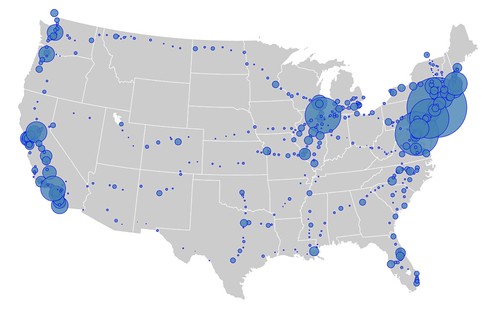
Image by Michael Hicks on flickr.
Note: Map creator Mike Hicks updated the map to remove Amtrak bus connections, and add Canadian cities where Amtrak trains end. This post has been updated with the new map. He also supplies the first draft of a separate close-in map of the Northeast. – February 6, 2013
Average Rating: 4.8 out of 5 based on 288 user reviews.
February 4th, 2013 | Permalink
Tags: intercity, maps, transportation

Fun things happen on Twitter. John Lisle, the DDOT staff person who runs their account, is moving to DC Water and giving up @DDOTDC. Since he’s leaving, he let loose with some of the agency’s closely guarded secrets yesterday. They’re copied here, for those of you who missed them on Twitter.
- Bikeshare was the brainchild of Al Gore. He sold it for $500M.
- “DC Streetcar” is really just a model we keep around the office pic.twitter.com/I1ZmiU2f
- There is a Metro station in Georgetown but it’s VIP only.
- We threw out the L’Enfant Plan when we stopped eating French Fries.
- We have no idea who designed the Dave Thomas Circle (but it smells so good!)
- We have a fleet of red convertible Solaras our employees can use anytime they want to hit the open road: t.co/0fg1bqPt
- There is 1 master switch for the streetlights and 1 for the traffic signals, but we don’t know which is which.
- We don’t have a clue what our logo means, but we like it.
- There is no @DDOTDC. This has all been a hoax.
Average Rating: 4.6 out of 5 based on 228 user reviews.
February 1st, 2013 | Permalink
Tags: fun

|
Media





Site
About BeyondDC
Archive 2003-06
Contact
Category Tags:
Partners
|





















